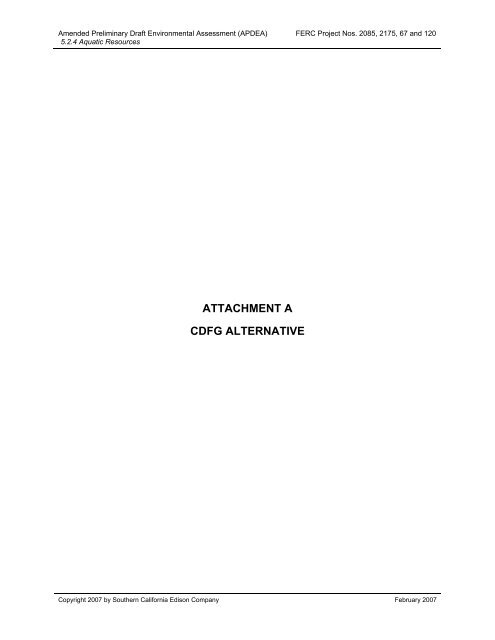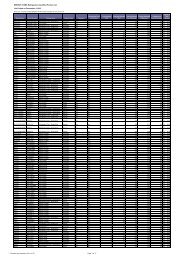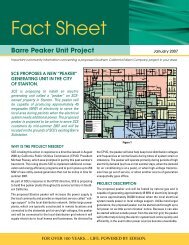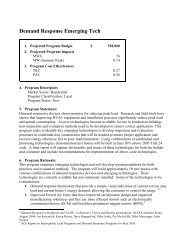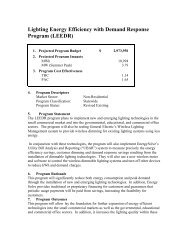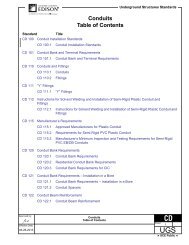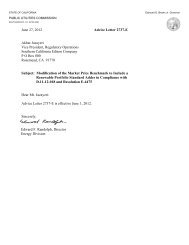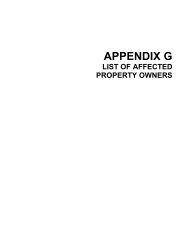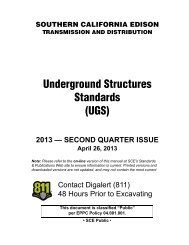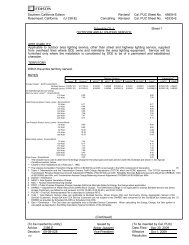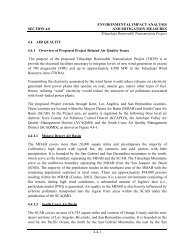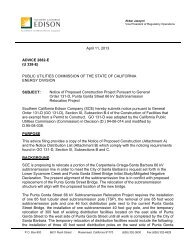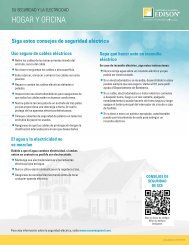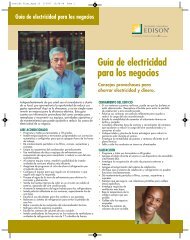ATTACHMENT A CDFG ALTERNATIVE - Southern California Edison
ATTACHMENT A CDFG ALTERNATIVE - Southern California Edison
ATTACHMENT A CDFG ALTERNATIVE - Southern California Edison
Create successful ePaper yourself
Turn your PDF publications into a flip-book with our unique Google optimized e-Paper software.
Amended Preliminary Draft Environmental Assessment (APDEA)<br />
5.2.4 Aquatic Resources<br />
<strong>ATTACHMENT</strong> A<br />
<strong>CDFG</strong> <strong>ALTERNATIVE</strong><br />
FERC Project Nos. 2085, 2175, 67 and 120<br />
Copyright 2007 by <strong>Southern</strong> <strong>California</strong> <strong>Edison</strong> Company February 2007
Jnofflclal FERC-Generated PDF of 20051027-0168 Received by FERC OSEC 10/26/2005 in Docket#: P-2175-000<br />
-~Re of Callfomb - The Resources Agency<br />
~ O F FISH AND GAME<br />
San Joequ~ Valley and 8outhem S~m Region<br />
1234 F_.~'t Shaw Avenue<br />
Frmno, Ce~orrfla 93710<br />
(55~) 243-4006<br />
Mr. Jeff McPheeters<br />
Manager, Northem Hydro Region<br />
<strong>Southern</strong> <strong>California</strong> <strong>Edison</strong> Company<br />
Hydro Generation Division<br />
2244 Walnut Grove Avenue<br />
Post Office Box 800<br />
Rosemead, <strong>California</strong> 91770<br />
Dear Mr. McPheeters:<br />
October 17, 2005<br />
ORISINAL<br />
ARNOLD .~ltW.~EMEGGE~ Governor<br />
;" ~" ~ c~ o~ "~<br />
C%,',<br />
• *..,<br />
"")- O" ~..~ c~l~<br />
Comments on the Settlement Proposal recommerKled by <strong>Southern</strong> <strong>California</strong> <strong>Edison</strong><br />
for relicensing of the Big Creek Hydroolednc Projects Big Creek Nos. 2A, 8 and<br />
Eastwood (FERC No. 67), Big Creek No. 3 (FERC NO. 120), Mammoth Pool (FERC<br />
No. 2085, and Big Creek Nos. 1 & 2 (FERC No. 2175)<br />
San Joaquin River Watershed<br />
Fresno County<br />
The D e ~ of Fish and Game (Department) is charged, under State law,<br />
with respoosibility as <strong>California</strong>'s principal steward of public trust for fish and wildlife<br />
resouro~ (see State Fish and Game Code, Sections 1802, 711.4). In Ittat capacity, we<br />
are participating, a~ with <strong>Southern</strong> <strong>California</strong> <strong>Edison</strong> (Licensee), olher agencies, and<br />
stakehoklers in the ARemative Licensing Procedure (ALP) process for the above listed<br />
Hydroelectric Projects. VVe have reviewed the current Settlement Proposal advanced<br />
by the Ucensee% ~ong with a~xnat.~ IXOposab that were =Jbm~ted by other<br />
Stakeho~le~ Ihat are part~pa~ng in the ALP Collabora~ve. We ~ that the<br />
final Seffiemertt Agreement anticipated to be developed by the ALP Collaborative will<br />
propose resource recomme(Klatior~ that indude fish and wildlife protec~on, mitigation<br />
and onhacement meaax~, which will be ~bmitted to the Federal F_neq~ Reg~ato~y<br />
Commission (FERC) for kmlualo~ in the FERC license for the above referenced<br />
hydroeleddc Projects.<br />
We I~elieve tt~t ttm ongoing ooll~r~ive process is one u~ful focum for the<br />
• ~oping of iuuee m~d for sC~a~lder involvement in deve~ ~ resoume<br />
~ . Tlle D e ~ generally concum W~l Ule incnvidual ~ tl~t have<br />
been proposal thus far within the Ooll~mfive, wxl we offer some additior~ heraln.<br />
We hope to evontu~ty become a sign~o~/to the Sealement Agmemont when it ~<br />
fir~lized by the ALP Coll~tive. Based on a review of the ~xrent ~ttlement<br />
~.
]nofflclal FERC-Generated PDF of 20051027-0168 Received by FERC OSEC 10/26/2005 in Docket#: P-2175-000<br />
Mr. Jeff McPheeters<br />
October 17, 2005<br />
Page 2<br />
proposal, and our ongoing participatk:~ in the Collaborative, the Depedment has the<br />
following comments on the Settlement Agreement Proposal that has bean developed<br />
thus far, along with the draft recommendations proposed by the group.<br />
AQUATIC RESOURCES<br />
Downstr(~m AINldmmous Fisheries and Temoerature Control Issues:<br />
Our Department is the judsdmtional agency which erfforces the <strong>California</strong> Fish<br />
and Game Code. Section 5937 of this Code statea that =the owner of a dam shall allow<br />
sufficient water at all timea to pass through a fishway, or in the absance of a fishway,<br />
allow sufficient water to pass over, around or through the dam, to keep in good<br />
condition any fish that may be planted or exist below the dam."<br />
r~ ~ is concon~d ~ c~)t Pro~ ot~)rmio~, wmer s~mOo =)d<br />
seasonal patterns, and quantities of water releases from Project reservoirs fail to keep<br />
in good conddJon fish below Project dams saveral downskeam reaches of the San<br />
Joaquin River wmershed. These fishes' co¢~eio~ =Jrvival and recovery are par~ally<br />
dependont upon adequate re~aeas of water now held ~md usad eaasonally within the<br />
subject Project reservoim. This ccxmern includes the maintenance of stream channel<br />
and floodpkzm funcSon, nocmally associated with regular interval flows which forrn and<br />
maintain the fish habitat d'mractedstics. The o ~ of Project reservoirs is<br />
proportior~lly responsible for clrect, indmct ~ cumulative fishery impacts in the<br />
tributaries and San Joaquin River. The issues associated with ~ m fishery<br />
protection, ircttxJing Section 5937 have not been adequately addressed by the ALP to<br />
date.<br />
Dowr~tmam of the =Jbject Project kacatione, and dependont upon their<br />
ope~tions, is Ffi~mt Darn, operated by the U. 8. Bureau of Reclamation (USBR).<br />
Behind Friant Dam is MiBerton Lake, with a total volume of 578,000 acre feet. "ll"m dam<br />
dynamically regulates a much larger qusntJty of water each year; however, the eaasonal<br />
inflow to Millerton lake is largely dependent upon the timing and volumes of water<br />
releasas made upslTsam at the Big Creek Project system resarvoirs (4 under ALp; 3<br />
othem under traditionat red). Thus, the Big Creek wstem operation has direct,<br />
indirect and oumulative effects on re=mrvolr o ~ and protection of fishe~j<br />
resoumes well ~ in the watershed.<br />
I.a~ year, in Nalural Reaources Defense Council (NRDC) v. ~ . a federal<br />
district (x~rt in Sacramento ruled that the USBR had violated Seclk~ 5937 by failing to<br />
mleaea =ufficis~ flows to keep in good ~ the ~ f i s h populations,<br />
including ar~adromous salmon runs that were ultimately extirpated in the late 1940s<br />
when Friant Dam became fully operal~d. The federal court will be detecmining<br />
remedies for the USBR's Section 5937 ~ in a trial commencing in February, 2006
Jnofflclal FERC-Generated PDF of 20051027-0168 Received by FERC OSEC 10/26/2005 in Docket#: P-2175-000<br />
Mr. Jeff McPheaters<br />
October 17, 2005<br />
Page 3<br />
with a decision expected by May, 2006. That decision is ar~dpated to include<br />
recommended flows for downstxeam fisheries pursuant to Section 5937. Preliminary<br />
analyses of the appropriate irish'earn flows needed for fishe~ recovery purposes<br />
indicate that the timing of releases from the upsb'eam reearvo~rs operated by t~e<br />
Licensee (with a total volume of about 630,000 acre feet) may be useful in seasonally<br />
supplementing any Friant Dam fishery releases in certain water years. Coordinated<br />
operations of the Big Creek system to supplement any flows from Fdant Dam required<br />
by the federal court may assist in providing for optimum fishery flows downstream. It is<br />
the Department's opinion that modifications will ever~ually need to be made in Big<br />
Creek Project operations in order to proportionally mitigate for the direct, indirect and<br />
cumulative effects of those o ~ on ~ fisheries, and keep those<br />
fisheries in good condition as suggested by Section 5937. Project modifications should<br />
eventually be coordrlated with Friant Dam operat~ns. ,Nthough Frtant Dam was a<br />
prime cor~lx~ng factor to the decline of downstream freshwater and anadrornous<br />
fisheries, the Big Creek Project dams also had propo~onal impacts. Again, the<br />
Department believes such ixoportional impacts must be addressed through operational<br />
changes such as flows re/ease of appropriate temperature and timing.<br />
Historically, spring-run Chinook salmon (about 120,000 per year), fall-run<br />
Chinook salmon (about 25-30,000 per year) and steelhead rainbow trout (undetermined<br />
numbers) annually migrated up the San Joaquin River to spawn each year within the<br />
Project's reach. Spring-run salmon were documented to over-summer in the upper<br />
(cooler) reaches of the dyer at elevations up to 6,500 feet; i.e., ~11 within the<br />
bounder~ of the subject power licenses. A significant percentage of the spring run's<br />
accees to cooter over-.~Lznrner habitat was blocked in 1916 by the constnclJon of<br />
Kerdd'Kdf Dam by (then) Pacific Power and Light Company (FERC Project No. 96;<br />
Pacific Gas and Electric Company). After that time, a smaller population of spring-run<br />
salmon persisted within the remaining summer habitat downstream. Kerckhoff<br />
Raservoir storage is very smalt, corBequer~, this Project was, and stm is, operated as<br />
a run-of-ihe-dver power planL This re.inK)Jr has in~dficient atorage capacity to alter<br />
major water flow volumes, or to modify downsb'em~ tempenatures, yet is of sufficient<br />
height to block fish migrations upstxlmm.<br />
The Big Cresk Project reservoirs were constructed atter 1916. While this sariee<br />
of Project dams may not have directly obetxtcted the upstream salmon er¢l steeiheed<br />
m i ~ they did direcSy, indirec~ arKI cumulath~ly affect the timing and magnitude<br />
of water reeas~; easec~ly by sto.ng spring =mowmelt runoff, then releasing the<br />
water later in the summer and fair period% for power ~ A subge increaes in<br />
fall flows may have been bene6ctal for the upe~eam migrant fall-run salmon, and<br />
steslhead betow the dams, but the eariously reduced spring water flows downstream of<br />
Kerckhoff Dam remain a serious concern today. We have completed 50-plus years of<br />
research on t~ other rnajor San Joaquin River tdmmaies, which indicatas that today,<br />
salmon populations in the San Joaq~n watershed are strongly deper~le~ upon the<br />
co m, s== 187o
Jnofflclal FERC-Generated PDF of 20051027-0168 Received by FERC OSEC 10/26/2005 in Docket#: P-2175-000<br />
Mr. Jeff icPheeters<br />
October 17, 2005<br />
Page 4<br />
timing, volumes and temperatures of spring flows originating from the upper watershed<br />
areas. As the Big Creek Projects are within this upper watershed, and did have the<br />
impacts described, we feel it is entirely appropriate and necessary to address these<br />
issues in this relicensing venue.<br />
Flow volumes during migration periods are a critical controlling factor in the<br />
survival of juvenile salmon as they migrate to the Pacific Ocean and, juvenile survival is<br />
directly and s~ly related to adult salmon produc~on. Consequently, there is little<br />
question that the Big Creek Project facilities and operations have directly contributed to<br />
reduced sp~ing and fall-run salmon populations in the San Joaquin River watershed. To<br />
supplement fishery restoration in the lower watershed, stored Big Creek Project water<br />
may need to be released to downstream resenc~rs and thence the river earlier in the<br />
drier series of years. To the extent other uses of Milledon Lake water are allowed in the<br />
NRDC v. Rodgers litigation, then water from the upstream Big Creek reservoirs may be<br />
useful in larger volumes in many more years,<br />
It is apparent to us thaE (i), the federal court has found that file federal Friant<br />
Unit of the Central Valley Project is governed by Section 5937, (ii) fish protection and<br />
recovery dowrmbeam of Friant Dam, is expected to be required by the court, (iii) such<br />
protection and recovery may be supplemented by the operatmns of the ups~'eam<br />
reservoirs of the Big Creek Project now undergoing license renewals, (iv) the FERC and<br />
USBR should work collabora6vely to determine the relationship of upstream storage to<br />
fishery flow r e o ~ dowrkstream (including the San Joaquin River below Fdant<br />
Dam), (v) direct, indirect and cumulative impacts of Project o ~ on downsb'eam<br />
fisheries should be addressed in the NEPA analysis associated with the Project<br />
relicensing proceedings, with apple mitigation and enhancement considered, and<br />
(vi) water quality (e.g. tempemttxe) issues should be addressed in the State Water<br />
Resources ConUol Board (SWRCB) Section 401 water quality certification and<br />
elsewhere as necessary. In conclusion, it is our position that the ~ fisheqf<br />
proteclJon mandate under Section 5937 has not been adequately addressed in the ALP<br />
or the I_ieensee's ctsre~ ~llement Propo~t Because each d lhe Hydmeledric<br />
Projects participetes direclly, ino~rectly and cumulatively affecting the downstream flow<br />
quanffiy and qual'ey (e.g., temperature) issuem, we reqc.~ that these effects be<br />
specifically co¢~idered in the pmoess of developing license artJdes and provisions for<br />
the individual r~emes, and the Big Creek sys~rn compmhensive~. These effec=<br />
should also be considered in the CEQA and NEPA procees related to the Project Our<br />
downstmmn fishery and water quanty concerns were identJr~ and documented as<br />
significant issuee during the collaborative proceedings, in particular, dunng discussions<br />
related to CAWG-13 p~komous Fish technical study.<br />
We ~ mat today, the Ce~ Va,ey sprtng-run C~nook s=mon<br />
Evolut~'larily Significant Unit (ESU) is listed as "lhreatermcr' under the Federa/<br />
Endangered Species Act (ESA). Populations of Central Valley spring-run Chinook<br />
Cons, na C 's 187o
Jnofflclal FERC-Generated PDF of 20051027-0168 Received by FERC OSEC 10/26/2005 in Docket#: P-2175-000<br />
Mr. Jeff McPheeters<br />
October 17, 2005<br />
Page 5<br />
salmon are significantly reduced below historical levels. Wdhin the San Joaquin River<br />
Basin, the spring-run Chinook salmon population has been extirpated, (although a few<br />
adults originating from norlhem ~ Valley watersheds stray into the San Joaquin in<br />
wet years). The loss of the huge historical San Joaquin Basin contingent of spring-run in<br />
the Central Valley rivers is a major basis for their ESA listing.<br />
Central Valley fall-run Chinook salmon are de=sifted as a "Species of Concern"<br />
under the federal ESA,, in part due to the tenuous year-to-year status of their<br />
populations in many of the San Joaquin River tnlxt, my streams. Although currently not<br />
protected under the ESA, recovery off'all-run Chinook salmon and recovery will involve<br />
all of the water operations mitigation measures discussed herein that will be oross-<br />
coordinated among and/or between the various other water operators within the major<br />
San Joaquin River tributanes, so as to achieve a coordinated schedule of flows and<br />
temperatures, and to cumulatively satisfy the Federal Clean Water Act water quality<br />
standards as adopted by the State Water Resources Cont~ Board within the<br />
downstream Delta and Estuary.<br />
Valley steeBlead rainbow bout are also listed as threatened under the<br />
ESA and, like fall-run Chinook salmon, are represented by seriously reduced San<br />
Joaquin River populations. Recovery of stealhead and fall-run Chinook salmon is a<br />
focus of our present concern. The present-dey total absence of populations of these<br />
species within their historical upper main-stem San Joaquin River habitat is a key factor<br />
in their current status in <strong>California</strong>. They are now geographically restricted to habitats<br />
below low-elevation dams in the other major San Joaquin River tributaries, and even<br />
those populatJons are subject to the modifications made by those dams to natural water<br />
flows and temperatures.<br />
We believe that the collective operations of SCE's four subject upstream<br />
hydroelectric Projects (along with the three SCE hydro~ectdc Projects currently in<br />
tmclitJonal relicansing) and the olher hydroete~c Ik:emes within the other trixCBtas of<br />
the San Joaquin River watershed, materially affect the hyckcdogical, thermal and water<br />
quality regimas on much of the San JoaqtJln River waterlhed. If these operalions<br />
and/or the associated facilities are appropdataly modified, downstream fish populations<br />
can be maintained in good condign.<br />
Rest~ ~ for all of these ~ spedes ere sttared by the<br />
Department, the United States Fish and Wildlife Sense (USFWS), NOAA Fisheries,<br />
and the joint Fedena-State CALFED Bay-Delta Authority. The restoration ~ are<br />
also reiterated within the Federal Central Valley Project Improvement Act (CVPIA),<br />
which spedfically calls for measur~ intsnded to double the natmal production of<br />
anadromo~ fish populations ttcoughout the Central Valley watersheds. The CALFED<br />
Bay-Delta Authority and the USFWS's Anadromous Fish Reston~on Program (pursuant<br />
to the CVPIA) have jointly expended in excess of $30 million on anadromous fish<br />
Co=ewina Car_rfonaa's ffarrfe since l szo
]nofflclal FERC-Generated PDF of 20051027-0168 Received by FERC OSEC 10/26/2005 in Docket#: P-2175-000<br />
Mr. Jeff McPheeters<br />
October 17, 2005<br />
Page 6<br />
restoration projects within the San Joaquin River watershed over the past decade. This<br />
has induded millions of dollars expended specifically within the San Joaquin River<br />
watershed to recover historically reduced salmon spawning and rearing habitats and<br />
fish screens.<br />
We ulxlarstand that the USBR is cun'ently developing a comprehensive water<br />
temperature model for Millarton Lake, for the lower San Joaquin River watershed, in<br />
r e ( ~ of the importance of water t e m ~ downstream of Fdant Dam to<br />
anadromous fish survival, reproduction, and ultimate recovery. Further studies,<br />
hydrologic and temperature modeling, are necessary to determine appropriate,<br />
contributJonal Project releases for fisheries downstream of Friant Dam.<br />
In summary, the Department requests that the Project Licenses be conditioned to<br />
require a study of fishary requirements downstn~am of the Project dams, including a<br />
proport~'~ate conVtbution to flows and water quality (e.g. temperature) downstream of<br />
Friant Dam in coordination with any flows required by the NRDC v. Rodaers lira. A<br />
public review of such study results should be required at an appropdate time interval,<br />
similar to the review provisions included in other projects in the San Joaquin River<br />
watershed (see FERC License No. 2299, New Don Pedro Project, on the Tuolumne<br />
River). We request that such a review would be combined with a well-focused license<br />
re-opaner condition that would allow consideration and adoption of addd~¢~ or revised<br />
license oond~onslar'ddes on one or more of fire Big Creek licenses currently in<br />
relicansing (ALP or Traditional). The review should include the results of the upstream<br />
operational and temperature modeling conducted by the Licensee for the ALP process,<br />
linked together with the model developed by the USBR, along with other ongoing besin-<br />
wide modeling to assess the direct, indirect and cumulative impacts of the Projects and<br />
evaJuate and de~e a/temat/ve operatkx~ s~mteo~ ovar me next five years (2¢X)5-<br />
2010). Changes in Ucanse ~ or o|tlar outcomes could occur tt~mef~.<br />
In developme~ of the NEPA documentation for the subject Project licenses, we<br />
request that an aplxopdato analysis be provided, which takes into consideration the<br />
ourrer~ (m =he t~me) produc= of me a~x~,e- deecribed mode~-~g effo~, e~erm=<br />
tolerance criteria of the San Joaquin River salmon, es developed and described above.<br />
The NEPA documentation should also address the (~mct, indirect and cumulative<br />
impacts of the continued operat~ of upstream reservoirs upon the downstream<br />
feb popu o and the a m y-ooeUy effo to re=om the hi=ork<br />
numarous populations, at leest ~o ltm doubling go~, as establist~d by Cortgre~s in Itm<br />
CVPIA, and as necessary to satisfy ESA requirements.<br />
Finally, the NEPA document should be alruclured in such a marmar tttat ESA and<br />
NEPA compliance essociated with subsequent decisions to add/revise license articles<br />
and any protection, mitigation and enhancement measures adopted, can be<br />
accomplished efficiently. We have many years of pragmatic experience and scientific<br />
co, ma cd, foma's :sm
Jnofflclal FERC-Generated PDF of 20051027-0168 Received by FERC OSEC 10/26/2005 in Docket#: P-2175-000<br />
Mr. Jeff McPheeters<br />
October 17, 2005<br />
Page 7<br />
information concerning the runs of salmon within the maw San Joaquin River<br />
tributaries and along the San Joaquin River, including the subject Project areas. We<br />
can provide this assistance upon request.<br />
Resident Fish Irlstmam Flow Recommendations:<br />
Based on its review of instresm flow studies, geomorphology studies, and other<br />
aquatic technica/~ prepared for the current reficansing, the Deparlment has<br />
developed recommended instnmm flows for the twenty-three (23) stream reaches of the<br />
Upper San Joaquin River and Ifibutades that are affected by the Projects (not including<br />
the stretches below Fdant Dam). These recommended instmam flows are summarized<br />
in an ~ to this letter (Allact.Tm~ A). The general rationale for the<br />
Department's flow recommendations indudes the following concepts:<br />
1) In gecmral the Deparbne~ recommends morn gradual b'ansitio~s dur~<br />
seasonal changes in req, lrecl minimum flows (ramping criteda). This avoids<br />
abrupt changes in water levels, which could result in the stranding offish,<br />
macroinvertebrates, and other aquatic organisms and will serve to provide a<br />
more natural annual hydrological regime.<br />
2) The recommended flows reflect improved provision of increased flows for<br />
spring spawning fish, and increased thermal protection for the stream<br />
fishedes and other aquatic organisms, along with ~ passage in late summer<br />
and fall, when low water leveis often result in t e m ~ that are<br />
deleterious to cold water fish.<br />
3) For ¢iverted roaches that are located at lower elevations within the upper San<br />
Joaquin River watershed, the Department recommends that higher flows for<br />
spring spawning fish and other aqu~c organisms be initiated earliar than at<br />
high stevaflorm, in order to coincide wilh earlier warm up of these lower<br />
elevation areas.<br />
4) The Department's recommended ~ flows are assumed to be Minimum<br />
Inskeam Flow (MIF), or inflow, whichever is less. Regular frequencies of high<br />
oftannel ~d f l ~ rrminter~ flo~ am to o~ es we~L<br />
5) The management of sed'm~ent accumulating at Project facilities is critical to<br />
healthy Mmam ecosystems. The sediment management program for the Big<br />
Creek system is a key element of file t.icenses.<br />
Some flow recommendations may need to be re-evaluated based on the need to<br />
coordinate flow releases with Friant Dam operations in the future.<br />
co e= c=r fo 's si,=e l szo
]nofflclal FERC-Generated PDF of 20051027-0168 Received by FERC OSEC 10/26/2005 in Docket#: P-2175-000<br />
Mr. Jeff McPheeters<br />
October 17, 2005<br />
Page 8<br />
Mammoth Pool Silva" Icx~ide Monitodna:<br />
The licensee currenUy contracts for the application of silver iodide in the<br />
watershed to enhance rainfall in the upper San Joaquin River watershed which is<br />
intended to increase water yietds for Project operations. Silver iodide applicat~ns are<br />
delivered using both aerial application and ground generating stations. Water quality<br />
studies conducted in support of the current Project relicensings have identified elevated<br />
levels of" silver in composite liver samples of adult trout in Mammoth Pool Reservoir.<br />
Muscle tissues (filet) in sampled fish did not demonstrate elevated silver levels. While<br />
silver levels in fish muscle tissues do not appear to be preserd at levels that would<br />
adversely affect humans or wildlife, live sample results are of concern to the<br />
Department. Consumption of fish that contain elevated levels of s/Iver in liver tissue<br />
may not pose a threat to ~ , who nommlly oonmm~ only muscte (filet) tissue.<br />
However, raptors and other large wildlife that regularly consume the entire carcass,<br />
induding liver tissues, may eventually consume and bioaccumulate suffident silver to<br />
cause deleterious effects. W11dlife at other trophic levels may be more sen@Jve. In<br />
addiUon, the source of the uptake of ~"ze sitver in fish t~ssues, which may be<br />
macroinvertebrates such as crayfish, should be identified.<br />
The Department recommends that a monitoring program, designed to identify<br />
trends in lhe levels m¢l source(s) of silver accumulation in pertinent fish tissues (e.g.<br />
liver and musc~), and the tissues a~l whote bodies of aquatic organisms regulady<br />
consumed by fish (such as crayfish or other macroinvertebrates), over Urne, should be<br />
conducted on approfx~e intervals (e.g. every 3 years) during the tern1 of the license for<br />
the Mammoth Pool Project area. The program should be conducted in the balance of<br />
the Project ~ and stream reaches, but with longer saml~ing intervals (e.g. every<br />
5-10 years) as warranted by the geography of, silver iodide application, and as more<br />
limited "spot" sampling suggests. The program should be developed in consultation<br />
with the D e p ~ SWRCB, the United Statee Fish and V~ldlife Service (USFVVS),<br />
and oU r approw a agemm. ^ descnl ng the vm0us mon or and<br />
reporting elements for silver in fish and ~ should be defined as a<br />
Project I ense term.<br />
Proiect Resenloir Minimum Pools:<br />
The D e ~ recornmercls that retention of water in Project reservoirs for<br />
recreational ~ b e balanced with the needs of resident trout and downstream<br />
enadromo fishedes. Current opemtkx minm m poo in the Project aru ok) not<br />
appem to ~Jveraely affect the fishedee wi~in Project r(men~irs; however, changes in<br />
reNrvoir oper~Jons dev~ dudng lhe ALP rnay result in ddfemnt oper~Jonal<br />
scenarios, related to Uming of flows and minimum pool levels, which could affect aquatic<br />
resoumes in ~ or downstream. Monitork~ for impacts to aquat/c<br />
c or 's rrfe si e 18ro
Jnofflclal FERC-Generated PDF of 20051027-0168 Received by FERC OSEC 10/26/2005 in Docket#: P-2175-000<br />
Mr. Jeff McPbeetars<br />
October 17, 2005<br />
Page 9<br />
resources in reservoirs should be included as part of the resource monitoring program<br />
developed for inclusion in the Settlement Agreement. Provisions for remedial acOons<br />
should be included.<br />
Fi~ Entraiqmont Mortality:<br />
The Department has the authority, based upon Fish and Game Code Chapter 3,<br />
Articles 1 through 5, at seq., to require installation offish screens on power diversion<br />
facilities that the Department has datenlnined to cause enlTainment of a significant<br />
number of fish. Based upon our review of the entrainment stuclies conclucted for the<br />
mlicensing, the Depadment will propose that drop tube intakes in the Project area,<br />
primarily those diversions that provide water to the Ward Tunnel, be screened to<br />
exclude and not impinge adult fish. Larval and juvenile fish, invertaix'atas and other<br />
wildlife will continue to be lost there and dsewhem in the Projects area. In addition to<br />
¢onstmct~ of the screens ~ above, the Department will require that add~onal<br />
mitigation for ongoing fish loss fi'om ontminment/impingement at Project facilities and<br />
divecsions to offset these losses. Despite the msutts of the ontrainment studies<br />
conducted by consultants for the Licensee, which found that ontminment in Project<br />
facilities does not appear to be subatan'dal, the Department is aware that entrainment<br />
loss does occur, we deem it significant, and will require mitJgaUon. We encourage the<br />
Licensee to oonsult with us as soon as possible to define the scope and mechanism(s)<br />
to satisfy this mitigation obligat~ in e pcagmatic mariner.<br />
Data used to Determine Fish Dens~es in Project Reaches:<br />
The ~ is concerned that data used as a reference fo¢ fish densit~s<br />
within the Project area is limited to those found in the report entitled "Fish Population<br />
and Yield Estimatas from <strong>California</strong> Trout Streams" (Eric Geratung, <strong>CDFG</strong>, 1973). The<br />
Depadment considers the fish density numbers in this report to be relatively low, and<br />
likely not ~ of the range of cun'e~ fi~ derudtJes in Project reaches. More<br />
rececd data is available, which we underMa~l that the ~ obtained from our Wild<br />
Trout Program o(fice in Sacrame~. It appears that this more mcent clara was not<br />
used, and that the Licensee has rel'md entirely on fish density information contained in<br />
t h e ' ~ report. Tbe Depanmont contn4es to remmmend that more recent<br />
infannation be used to provide more current mfecenee information for Esh decBilJes in<br />
the Project area and as a basis in environmental documentation or evalua'dons.<br />
Hatchery Surest for Stockina of Project Imooundments and Proiect-Aff~mtad Reaches<br />
The Project attracts a high amount of puldic recreation use, which indudes<br />
angl'mg in Project affected reservoirs and streem/river reaches. This has become an<br />
important economic element in the nearby, ~ n communit~s, and is an attraclive<br />
feetum f~ stimulating ~ expendihJr~ in the Freeno Meb'apoli~ area and<br />
eL~vhem. Tnis intensifies fl~ing pre~um in Project ~mnl reache% re~rvoim and<br />
nearby waters. The Department also re(x)gr~es that the Project, as a whole, has<br />
adversely affected the upper basin flshecy by changes in Uming and amount of inst~eam<br />
C 's Sin 18m
Jnofflclal FERC-Generated PDF of 20051027-0168 Received by FERC OSEC 10/26/2005 in Docket#: P-2175-000<br />
Mr. Jeff McPheeters<br />
October 17,<br />
Page 10<br />
flows from those that occurred historically, in addition to the level of entrainment and<br />
entrapment in Project facil~es ~ diversions. Therefore, file Department requests that<br />
the Ucensee reimburse the Depar'm~t for me ongoing cost for fish stocldng, along with<br />
efforts fo¢ fish production and monitoring, that ere needed to sustain a high quality<br />
recreational fishery in Project impoundments and Project affected reaches and nearby<br />
waters in the upper San Joaquin River watershed. The cun-ent cost, as estimated by<br />
theDepertme~ is in the rar~ of S3OO, OOOeachyem. This excludes mitigation for<br />
entrainment and entrapment Ioeses discussed above. This amount would need to be<br />
provided on a consistent basis over the term of the renewed License, end re-evaluated<br />
annually, and adjusted for inflation and increasing levels of use over time. We<br />
ermota'age the Licensee to consult with us as soon es possible to define the scope and<br />
mechanisms to satisfy this mitigation obligation.<br />
1600 Stream Alte~n Malntermnce Ameeme~ for Sediment Maintenance:<br />
A Stream Alteration Maintenance Agreement is currently in place that addresses<br />
the oagoing annual removal of sediment, vegetation, and other debris from many of the<br />
small and mid-sized impocmdme~ in the upper San Joaquin River watershed. This<br />
Agreement expires on July 31, 2006. We recommend that this Agreement be updated<br />
(perhaps for a longer term) upon its expi~ to ensure that adequate fish and wildlife<br />
protection is implemented during sediment management activities at Project facilities.<br />
Recommended sediment management plans may be attached to and incofl:xxaled into<br />
this Agreeme~ consisterd with, or in ~ to sedimerd management measures<br />
approved by the ALP Collaborative and FERC.<br />
Mammoth Pool Deer Protection:<br />
TERRESTRIAL RESOURCES<br />
The Deparbnent recommends the continualJon of Ucertse condibor~s irK~uded in<br />
the present FERC License, with one exception described below. These original<br />
measures were intended to protect deer by avoi¢ing or pattmlly m ~ impacts<br />
dudng migrations and/or residence in the erea of Mammoth Pool Reservo~'. The<br />
original conditk)ns irmluded the requirement that the LicertNe ~ mn~ in the<br />
vicinity of Mammoth Pool Dam to facilitate the envy and exit of deer that must swim the<br />
reservov. As staled pre~us~ by Depertme~ mff dmng the cdkaxnt~'e mee~g<br />
proceu, this meesure has not been completed to date, and we now recomme¢¢l that<br />
this item be deleted from the currant rmt of protecl~ve measures. "l'he Depertme~ does<br />
not continue to recommend the comtmclk~ of deer accees ramps neer the Mammoth<br />
Pool spi~uay, es these were located in solid rock, end not o0rKkcive to alfioient use by<br />
deer.<br />
The Deperlm~ remains concerned about the potential accumula~on of<br />
and debris in the reservoir, which could cause deer to drown while swimming the<br />
reservoir. The technical report for the mule deer study indicated that SCE does not<br />
cae/o,,='s I8;o
Jnofflclal FERC-Generated PDF of 20051027-0168 Received by FERC OSEC 10/26/2005 in Docket#: P-2175-000<br />
Mr. Jetf icPh~ters<br />
October 17, 2005<br />
Page 11<br />
regularly remove large debds from Mammoth Pool. Although no bash or other deb~<br />
was obsen~ed in the reservoir during the deer migration study conducted in 2002 for this<br />
mlioensing, historically, floating bash and debris am observed at bcth the envy and exit<br />
points along the defined deer migration routes, which could increase mortality of<br />
migrating deer.<br />
To ensure that the presence of debris is monitored, and t~at any build up of<br />
debris is removed in a timely way to protect migrating deer that swim the reservoir<br />
during annual migrations, the Depamne~ recommends that the Ucensee provide<br />
ar~ual photo documentation of the area of primary concern to the Departme~ along<br />
with an estimate of the aedat extent of debris buildup well in advance of the deer<br />
migration periods. This area is located at the floating boom above the spill way. If,<br />
based on lhe Departme~s review of the photooraph, and other informaUon regarding<br />
the aerial extent of any debris buildup present, the Department considers the buildup<br />
sufficient to expose deer to increase mortality, the Licensee would be requested to<br />
remove the debris before migrations begin. This measure should be added as a<br />
condition of~ lioense ~d/or ar~l eteme~ of b~ ,~ten'm~ Agmeme~<br />
W~ldJ~e Mortalk%,<br />
The technical studies that were conducted for the cun'ent relicensing did not<br />
identify significant wildlife mortaF~y within the Project area. However, because the study<br />
design was not intended to obtain such i ~ , the study would not likely identify<br />
the subtle, ongoing and significant mortality that occurs to diverse wildlife species as a<br />
reset of Projea mserv=rs, operauom (pa'Ucu~ ~ sp~l yea~) and Pro~ct associated<br />
Vaflic. The wildlife mortality observed in the study and generally by our staff on a<br />
regu~ basis is indicative of the wildlifi) mortality that occurs as a result of these<br />
Projects. The Depadmerd receives reports of deer and other wilclife mortality at<br />
Mammoth Pool and olher Project reservoirs over Ume. We believe Itmt as recreati~m/<br />
uses at Project reserv~m has increased, Iraf~ ~ mcmatior~ destinalions has<br />
increased, and the wil~ife loss due to road kill or injury has and will co~dnue to<br />
increase. Based on the above d~cussion and the Deparlme~s knowhxJoe of wildlife<br />
and their rnigmt~rw and use ~ the Project area, it is clear Itmt a level of Project-<br />
induced wildlife modal'dy occurs now and will ~ throuoh the barn1 of m l ~ .<br />
We believe ttu loss is significant due to Ihe consequecK:~ suffwed at<br />
~levels over the life of the Projects. For instance, aloss of a single doe (deer)<br />
may seem i ~ on the surface. But, when the ~ losses of fawns<br />
that the lost doe and theh" successive o~q~ing would have ixoduced over their lifelirnes<br />
am ~ , ,~e m~ea of each morta,ty ~pends so~ar~. T ~ ~<br />
"oppodun~ loss" to Itm popuWdon a'~d to ~'m berm~a~ uses. It is ttm Depadme~s<br />
ix~tion that deer and other wildr~ are lost on a consistent basis over time due to t~e<br />
Projects. Therefore, appropriate mi~gation measures should be irn~emented as an<br />
element of this mlicensing.<br />
c efo, ' si, szo
Jnofficial FERC-Generated PDF of 20051027-0168 Received by FERC OSEC 10/26/2005 in Docket#: P-2175-000<br />
Mr. Jeff McPheeters<br />
October 17, 20O5<br />
Page 12<br />
A broad array of mitigation slrategies should be considered and implemented in a<br />
Wildlife Mortality Mitigation Program. Some of these strategies to offset the mortality<br />
impact can be conckx~ed at areas outside of the Project boundary in older to provide<br />
popu~a'don benefits to the species involved. For instance, improvement of fawning or<br />
wintering habitat for the San Joaquin Mule deer herd to increase i:roduc~ is an<br />
appropriate mitigation measure to offset losses to this herd caused by Project<br />
operations. Sincethese habitat types may not exist directlyon the Project area, SCE<br />
and the Department would need to collaborate with the landowner(s) and implement<br />
projects, with funding from the Wildlife Mortality Mitigation Program. This mitigation will<br />
need to be conducted on an ~ng basis ok,ring the er~re lifespan of the Project's<br />
license in recognition of the ongoing wildlife mortality. Similar to the Fish Entrainment<br />
and Hatchery Support mitigation funding, a consistent source of funding over the term of<br />
the license is necessary for an effective program. The D e ~ ermourages the<br />
Licensee to consult with us as soon as possible to define and develop the scope and<br />
mechanism(s) to satisfy this component of Project's mitigation obligation.<br />
B~ M ~ "<br />
The Department is very concerned about recurring bear/human and other wildlife<br />
incidents at facilities in the Project area, especially in the town of Big Creek, which is a<br />
reside~al area for SCE employees. The bears are attracted to imixopedy stored food<br />
and garbage, causing potentially dangerous conflicts with humans. Bears<br />
in a manner that prese~ human safety or properly damage, rnay be removed or killed<br />
under State law. Thus, a Project induced impact (human development and mishandling<br />
of refuse), resutts in wildlife mortality, threats to safety and Ixopedy damage in some<br />
cases. The ~ strongly recommends that the Ucensee purcha~, employ and<br />
maintain bear proof dumpsters at all fadli~es within its scope of responsibility in and<br />
ad~aceflt to the FERC Project area and within the town of Big Creek for the duration of<br />
lhe reli~nsir~ pe¢~. The ¢Unpsters stccdd be of a quafdy ar¢l design equivalent to<br />
those effectively used in our local National Parks. We also recommefld that the<br />
Licensee amst ~te Defmlme~ by devek~ng and monitoring a mndatory e~ca~onal<br />
program on proper food storage and gadoage disposal for its employees and visitors, so<br />
that some bear/human inddents are prevented ttm0ugtm~ the Project areiL The<br />
Depaament can identify spedflc sites for these containers and for educaUonal material<br />
dispersal in consultation with our tony partners in the Project area.<br />
I;NK~lrlme~ Acce~ to Restricted FERC Project Areas:<br />
The Depmtnent regu~y conduc~ v~ife and aquaUc ~veys and enforcement<br />
activities in portions of the Upper San Joaquln River watenCmd, which may require<br />
acce. m Projea rm~aays ~ are cun~ ckmed m puree accms by rocked gain6.<br />
The I ~ will need to c~Y~nue to acce~m ~mN areas dunng file renewed<br />
license term, and requests continued cooperation by the Ucensee in granting access to<br />
these res~cted areas. As in the pwt, Departme~ staff will contact the Licensees as<br />
c. for = Isro
Jnofflclal FERC-Generated PDF of 20051027-0168 Received by FERC OSEC 10/26/2005 in Docket#: P-2175-000<br />
Mr. Jeff McPheeters<br />
October 17, 2005<br />
Page 13<br />
appropriate, and check out necessary keys to obtaJn access to these areas, with the<br />
exception of Department law enforcement personnel who will have access to restricted<br />
areas at all time. Law enforcement personnel will make prior arrangements with the<br />
Licensee to ensure that they have appropriate keys and/or lock combinations to<br />
restricted areas. No additional demand for fish and wildlife enforcement efforts are<br />
antidpated under the above conditions of this relicensing.<br />
We hope that these comments will assist you in completing the development of<br />
conditions and Ucense a~des for inclusion in a viable SetUement Ag~t and<br />
conditions for relicensing of the subject Projects. If you have any questions concerning<br />
these comments, please contact Ms. Julie Means, Environmental Scientist, o¢ Mr. Dale<br />
Mitchell, Environmental Program Manager, at the address on this letterhead or<br />
telephone number, extension 141. Thank you for this opportunity to provide the<br />
Oepartment% comments.<br />
Attachment<br />
cc: See Pages 14 -16<br />
Sincerely, /~<br />
W. E. Loudermilk<br />
Regional Manager<br />
Consm i Car ,mia's ls7o
Jnofflclal FERC-Generated PDF of 20051027-0168 Received by FERC OSEC 10/26/2005 in Docket#: P-2175-000<br />
Mr. Jeff McPheaters<br />
October 17, 2005<br />
Page 14<br />
cc: ~'Seoretary Magalie R. Salas<br />
Federal Energy Regulatory Commission<br />
888 First Street NE<br />
Washington, DC 20426<br />
Mr. Mike Henry<br />
Federal Energy Regulatory Commission<br />
888 First Street NE<br />
Washington, DC 20426<br />
Mr. Jim Canaday<br />
State Water Resource Control Board<br />
Division of Water Rights<br />
1001 I Skeet<br />
Sacramento, CA 95812<br />
Ms. Deborah Giglio<br />
US Fish and Wddlife Service<br />
2800 Cottage Way, W-2605<br />
Sacramento, CA 95825<br />
Mr. Michael Aceituno<br />
NOAA Fisheries<br />
650 Capitol Mall Blvd, Ste 8300<br />
Sacramento, CA 95814<br />
Mr. Steve Edmonson<br />
NOAA Fisheries<br />
777 Sonoma Avenue<br />
Santa Rosa, CA 95404<br />
Mr. Stacy Li<br />
NOAA Fisheries<br />
777 Sonoma Avenue<br />
Santa Rosa, CA 95404<br />
Mr. Phil Strand, Fisheries Coordinator<br />
Sierra National Forest<br />
1600 Tol/house Road<br />
Clovis, CA 93611<br />
Mr. Wayne~<br />
US Fish and Wildlife Service<br />
2800 Cottage Way, W-2605<br />
Sacramento, CA 95825<br />
Conse CarEom='s since l sro
Jnofflclal FERC-Generated PDF of 20051027-0168 Received by FERC OSEC 10/26/2005 in Docket#: P-2175-000<br />
Mr. Jeff McPheeters<br />
October 17, 2005<br />
Page 15<br />
CC" Mr. Mk:hael Hoover<br />
U.S. Fish and Wildlife Service<br />
280O Cottage Way, W-2605<br />
Sacramento, CA 95825<br />
Mr. Russel Bellmer<br />
U.S. Fish and Wildlife Service<br />
4001 N. Wilson Way<br />
Stockton, CA 95205-2486<br />
Mr. Bill Luce<br />
US Bureau of Reclamation<br />
1243 "N" Sb'eet<br />
Fresno, CA 93721-5116<br />
Mr. Ed Cole<br />
Forest Supervisor<br />
Sierra National Forest<br />
1600 East Tollhouse Road<br />
Clovis, CA 93611<br />
Ms. Cindy Whelan<br />
FERC Relicensi~ Coordinator<br />
Sierra National Forest<br />
1600 East To/Ihouse Road<br />
Clovis, CA 93611<br />
Ms. K~l~ L CaUe~<br />
Hydro Reform Policy Advocate<br />
Friends of the ITJver<br />
915 20th Sb-eet<br />
Sacramento, CA 95814<br />
Mr. Banky CurUs, I:~ Director<br />
Habitat C o r ~ Branch<br />
Department of Fish and C~Bme<br />
Ms. Ann Malcolm, Chief<br />
Depar~ of Fish and Game<br />
Mr. Hsxlee Bn~ch, Staff Counsel<br />
Department of Fish and Game<br />
Con=n Caafo,nia's arrfe since I8zo
Jnofflclal FERC-Generated PDF of 20051027-0168 Received by FERC OSEC 10/26/2005 in Docket#: P-2175-000<br />
Mr. Jeff McPheeters<br />
October 17, 2005<br />
Page 16<br />
CC." Mr. Kevin Hunting,<br />
Habitat Conservation Planning Branch<br />
Department of Fish and Game<br />
Mr. Sonke MastnJp, Deputy Director<br />
Wik:lJife and InJand FJshedes Division<br />
Department of Fish and Game<br />
Mr. Stan Stephens<br />
Department of Fish and Game<br />
Mr. Dale Mitchell<br />
Department of Fish and Game<br />
Mr. Randy Kelly<br />
Deparbnent of Fish and Game<br />
Mr. Dean Marston<br />
Department of Fish and Game<br />
Ms. Julie Means<br />
Department of Fish and Game<br />
si, 18zo
Jnofflclal FERC-Generated PDF of 20051027-0168 Received by FERC OSEC 10/26/2005 in Docket#: P-2175-000<br />
Department of Fish and Game<br />
Minimum Instream Flow Recommendations<br />
For the <strong>Southern</strong> <strong>California</strong> <strong>Edison</strong><br />
Upper San Joaquin River Hydroelectric Projects<br />
Big Creek ALP ReHeensing<br />
Huntington-Shaver Area<br />
Stream: Balsam Creek Reach: Diversion to Big Creek<br />
Month DFG wet year DFG dry year<br />
Oct<br />
2<br />
1<br />
Nov 1 1<br />
Dec 1 1<br />
Jan i 1<br />
Feb 1 1<br />
Mar 2 1<br />
Apr 3 2<br />
May 3 2<br />
Jun 2 1<br />
JRI 2 1<br />
Aug 2 1<br />
Sep 2 1<br />
<strong>ATTACHMENT</strong> A<br />
wet year = above average and wet water year types<br />
dry year = below normal, dry, and critically dry water year types
Jnofflclal FERC-Generated PDF of 20051027-0168 Received by FERC OSEC 10/26/2005 in Docket#: P-2175-000<br />
DFG Minimum Instream Flow Recommendations<br />
Huntington-Shaver Area<br />
Stream: Balsam Creek Reach: Forebay to Diversion<br />
Month DFG wet year DFG dry year<br />
Oct<br />
2<br />
1.5<br />
Nov 1.5 1.5<br />
Dec 1.5 1.5<br />
Jan 1.5 1.5<br />
Feb 1.5 1.5<br />
Mar 1.5 1.5<br />
Apr 3 3<br />
May 4 3<br />
Jun 3 3<br />
Jul 2 1.5<br />
Aug 2 1.5<br />
Sep 2 1.5<br />
<strong>ATTACHMENT</strong> A<br />
wet year = above average and wet water year types<br />
dry year = below normal, dry, and critically dry water year types<br />
2
Jnofflclal FERC-Generated PDF of 20051027-0168 Received by FERC OSEC 10/26/2005 in Docket#: P-2175-000<br />
DFG Minimum Instream Flow Recommendations<br />
Huntington-Shaver Area<br />
Stream: Big Creek Reach: Dam 4 to Dam 5<br />
Month DFG wet year DFG dry year<br />
Oct 10<br />
7<br />
Nov 7 7<br />
Dec 7 7<br />
Jan 7 7<br />
Feb 7 7<br />
Mar 7 7<br />
Apr 20 15<br />
May 20 15<br />
Jun 20 15<br />
Jul 15 10<br />
Aug<br />
Sep<br />
15<br />
15<br />
10<br />
10<br />
<strong>ATTACHMENT</strong> A<br />
wet year = above average and wet water year types<br />
dry year = below normal, dry, and critically dry water year types
Jnofflclal FERC-Generated PDF of 20051027-0168 Received by FERC OSEC 10/26/2005 in Docket#: P-2175-000<br />
DFG Minimum Instream Flow Recommendations<br />
Huntington-Shaver Area<br />
<strong>ATTACHMENT</strong> A<br />
Stream: Big Creek Reach: Dam 5 to the San Joaquin River<br />
Month DFG wet year DFG dry year<br />
Oct 10<br />
8<br />
Nov 8 8<br />
Dec 8 8<br />
Jan 8 8<br />
Feb 8 8<br />
Mar 8 8<br />
Apt 20 15<br />
May 20 15<br />
Jun 20 15<br />
J'dl 15 10<br />
Aug 15 10<br />
Sep 10 10<br />
wet year = above average and wet water year types<br />
dry year = below normal, dry, and critically dry water year types<br />
4
Jnofflclal FERC-Generated PDF of 20051027-0168 Received by FERC OSEC 10/26/2005 in Docket#: P-2175-000<br />
DFG Minimum Instream Flow Recommendations<br />
Huntington-Shaver Area<br />
Stream: Ely Creek Reach: Below the Diversion<br />
Month DFG wet year DFG dry year<br />
Oct<br />
1<br />
1<br />
Nov 1 1<br />
Dec 1 1<br />
Jan<br />
I<br />
Feb<br />
I<br />
Mar 1 1<br />
Apr 3 2<br />
May 3 2<br />
Jun 3 1<br />
Jul 2 1<br />
Aug 2 1<br />
Sop I 1<br />
<strong>ATTACHMENT</strong> A<br />
wet year = above average and wet water year types<br />
dry year = below normal, dry, and critically dry water year types<br />
5
Jnofflclal FERC-Generated PDF of 20051027-0168 Received by FERC OSEC 10/26/2005 in Docket#: P-2175-000<br />
DFG Minimum Instream Flow Recommendations<br />
Huntington-Shaver Area<br />
<strong>ATTACHMENT</strong> A<br />
Stream: NF Stevenson Creek Reach: Below Tunnel 7 to Shaver Lake<br />
Month DFG wet year DFG dry year<br />
Oct 12<br />
12<br />
Nov 12 12<br />
Dec 12 12<br />
Jan 8 8<br />
Feb 8 8<br />
Mar 8 8<br />
Apr 25 20<br />
May 25 20<br />
Jun 20 20<br />
Jul 15 12<br />
Aug<br />
Sep<br />
15 12<br />
12 12<br />
wet year -- above average and wet water year types<br />
dry year = below normal, dry, and critically dry water year types<br />
6
Jnofflclal FERC-Generated PDF of 20051027-0168 Received by FERC OSEC 10/26/2005 in Docket#: P-2175-000<br />
DFG Minimum Instream Flow Recommendations<br />
Huntington-Shaver Area<br />
Stream: Pitman Creek Reach: Below the Diversion<br />
Month DFG wet year DFG dry year I<br />
Oct<br />
2<br />
1.5<br />
Nov 1.5 1.5<br />
Dec 1.5 1.5<br />
Jan 1.5 1.5<br />
Feb 1.5 1.5<br />
Mar 1.5 1.5<br />
Apr 5 3<br />
May 5 3<br />
Jun 5 3<br />
Jul 3 1.5<br />
Aug 2 1.5<br />
Sep 2 1.5<br />
<strong>ATTACHMENT</strong> A<br />
wet year = above average and wet water year types<br />
dry year = below normal, dry, and critically dry water year types<br />
7
Jnofflclal FERC-Generated PDF of 20051027-0168 Received by FERC OSEC 10/26/2005 in Docket#: P-2175-000<br />
DFG Minimum Instream Flow Recommendations<br />
Lower San Joaquin River<br />
Stream: Rock Creek<br />
Month DFG wet year DFG dry year<br />
Oct 2<br />
2<br />
i Nov 2 2<br />
Dec 2 2<br />
Jan 2 2<br />
Feb 2 2<br />
Mar 4 3<br />
Apr 4 3<br />
May 4 3<br />
Jun 3 2<br />
Jul 2 2<br />
Aug 2 2<br />
Sep 2 2<br />
<strong>ATTACHMENT</strong> A<br />
Reach: Below the Diversion<br />
wet year = above average and wet water year types<br />
dry year = below normal, dry, and critically dry water year types<br />
8
Jnofflclal FERC-Generated PDF of 20051027-0168 Received by FERC OSEC 10/26/2005 in Docket#: P-2175-000<br />
DFG Minimum Instream Flow Recommendations<br />
Lower San Joaquin River<br />
<strong>ATTACHMENT</strong> A<br />
Stream: Ross Creek Reach: Below the Diversion<br />
Month DFG wet year DFG dry year<br />
Oct<br />
1<br />
.5<br />
Nov 1 .5<br />
Dec 1 .5<br />
Jan 1 .5<br />
Feb 1 .5<br />
Mar 2 2<br />
Apr 3 2<br />
May 3 2<br />
Jun 2 1<br />
Jul 1 .5<br />
Aug 1 .5<br />
Sep 1 .5<br />
wet year = above average and wet water year types<br />
dry year = below normal, dry, and critically dry water year types<br />
9
Jnofflclal FERC-Generated PDF of 20051027-0168 Received by FERC OSEC 10/26/2005 in Docket#: P-2175-000<br />
DFG Minimum Instream Flow Recommendations<br />
Lower San Joaquin River<br />
Stream: San Joaquin River Reach: Dam 6 to Redinger<br />
Month DFG wet year DFG dry year<br />
Oct 75<br />
50<br />
Nov 25 25<br />
Dec 25 20<br />
Jan 25 20<br />
Feb 25 20<br />
Mar 75 60<br />
Apr 100 80<br />
May 100 80<br />
Jun 100 80<br />
Jul 75 60<br />
Aug<br />
Sep<br />
75 50<br />
75 50<br />
<strong>ATTACHMENT</strong> A<br />
wet year = above average and wet water year types<br />
dry year = below normal, dry, and critically dry water year types<br />
10
Jnofflclal FERC-Generated PDF of 20051027-0168 Received by FERC OSEC 10/26/2005 in Docket#: P-2175-000<br />
DFG Minimum Instream Flow Recommendations<br />
Lower San Joaquin River<br />
<strong>ATTACHMENT</strong> A<br />
Stream: San Joaquin River Reach: Mammoth Pool to Dam 6<br />
Month DFG wet year DFG dry year<br />
Oct 120<br />
100<br />
Nov 100 100<br />
Dec 80 80<br />
Jan 75 60<br />
Feb 75 60<br />
Mar 75 60<br />
Apr 120 120<br />
May 150 120<br />
Jun 150 100<br />
Jul 120 100<br />
Aug 120 100<br />
Sep 120 100<br />
wet year = above average and wet water year types<br />
dry year = below normal, dry, and critically dry water year types<br />
11
Jnofflclal FERC-Generated PDF of 20051027-0168 Received by FERC OSEC 10/26/2005 in Docket#: P-2175-000<br />
DFG Minimum Instream Flow Recommendations<br />
Lower San Joaquin River<br />
<strong>ATTACHMENT</strong> A<br />
Stream: Stevenson Creek Reach: Shaver Lake to San Joaquin River<br />
Month DFG wet year DFG dry year<br />
Oct<br />
8<br />
5<br />
Nov 5 5<br />
Dec 5 5<br />
Jan 5 5<br />
Feb 5 5<br />
Mar 5 5<br />
Apr 15 10<br />
May 15 10<br />
Jun 10 9<br />
Jul 8 8<br />
Aug 8 8<br />
Sep 8 8<br />
wet year = above average and wet water year types<br />
dry year = below normal, dry, and critically dry water year types<br />
12
Jnofflclal FERC-Generated PDF of 20051027-0168 Received by FERC OSEC 10/26/2005 in Docket#: P-2175-000<br />
DFG Minimum lnstream Flow Recommendations<br />
South Fork San Joaquin River<br />
<strong>ATTACHMENT</strong> A<br />
Stream: Bear Creek Reach: Below the Diversion<br />
Month DFG wet year DFG dry year<br />
Oct 7<br />
7<br />
Nov 7 7<br />
Dec 6 5<br />
Jan 4 4<br />
Feb 4 4<br />
Mar 4 4<br />
Apr 12 10<br />
May 12 10<br />
Jun 10 9<br />
Jul 8 7<br />
!Aug 7 7<br />
Sep 7 7<br />
wet year = above average and wet water year types<br />
dry year = below normal, dry, and critically dry water year types<br />
13
Jnofflclal FERC-Generated PDF of 20051027-0168 Received by FERC OSEC 10/26/2005 in Docket#: P-2175-000<br />
DFG Minimum Instream Flow Recommendations<br />
South Fork San Joaquin River<br />
<strong>ATTACHMENT</strong> A<br />
Stream: Mono Creek Reach: Downstream of Mono Diversion<br />
Month DFG wet year DFG dry year<br />
Oct 30<br />
25<br />
Nov 25 25<br />
Dec 20 20<br />
Jan 20 20<br />
Feb 20 20<br />
Mar 30 20<br />
Apr 35 30<br />
May 35 30<br />
Jun 30 25<br />
Jul 30 25<br />
Aug 30 25<br />
Sep 30<br />
25<br />
wet year = above average and wet water year types<br />
dry year = below normal, dry, and critically dry water year types<br />
14
Jnofflclal FERC-Generated PDF of 20051027-0168 Received by FERC OSEC 10/26/2005 in Docket#: P-2175-000<br />
DFG Minimum Instream Flow Recommendations<br />
South Fork San Joaquin River<br />
<strong>ATTACHMENT</strong> A<br />
Stream: S. Fork San Joaquin River Reach: Florence Lake to Bear Creek<br />
Month DFG wet year DFG dry year<br />
Oct 40<br />
35<br />
Nov 35 35<br />
Dec 30 25<br />
Jan 30 25<br />
Feb 30 25<br />
Mar 30 25<br />
Apr 45 40<br />
May 45 40<br />
Jun 45 40<br />
Jul 40 35<br />
Aug 40 35<br />
Sep 40 35<br />
wet year = above average and wet water year types<br />
dry year = below normal, dry, and critically dry water year types<br />
15
Jnofflclal FERC-Generated PDF of 20051027-0168 Received by FERC OSEC 10/26/2005 in Docket#: P-2175-000<br />
DFG Minimum Instream Flow Recommendations<br />
Upper Basin Tributaries<br />
<strong>ATTACHMENT</strong> A<br />
Stream: Bolsillo Creek Reach: Below the Diversion<br />
Month DFG wet year DFG dry year<br />
Oct<br />
1<br />
1<br />
Nov I I<br />
Dec I I<br />
Jan I I<br />
Feb 1 I<br />
Mar I I<br />
Apr 3 3<br />
May 4 3<br />
Jun 4 3<br />
Jul 3 I<br />
Aug 2 1<br />
Sep 1 1<br />
wet year = above average and wet water year types<br />
dry year = below normal, dry, and critically dry water year types<br />
16
Jnofflclal FERC-Generated PDF of 20051027-0168 Received by FERC OSEC 10/26/2005 in Docket#: P-2175-000<br />
DFG Minimum Instream Flow Recommendations<br />
Upper Basin Tributaries<br />
<strong>ATTACHMENT</strong> A<br />
Stream: Camp 62 Creek Reach: Below the Diversion<br />
Month DFG wet year DFG dry year<br />
Oct<br />
1<br />
.5<br />
Nov .5 .5<br />
Dec .5 .5<br />
Jan .5 .5<br />
Feb .5 .5<br />
Mar .5 .5<br />
Apr 5 4<br />
May 5 4<br />
Jun 5 4<br />
Jul 2 1<br />
Aug 2 1<br />
Sep I 1<br />
wet year = above average and wet water year types<br />
dry year = below normal, dry, and critically dry water year types<br />
17
Jnofflclal FERC-Generated PDF of 20051027-0168 Received by FERC OSEC 10/26/2005 in Docket#: P-2175-000<br />
DFG Minimum Instream Flow Recommendations<br />
Upper Basin Tributaries<br />
A'I'I'ACHMENT A<br />
Stream: Chinquapin Creek Reach: Below the Diversion<br />
Month DFG wet year DFG dry year<br />
Oct<br />
1<br />
.5<br />
Nov I .5<br />
Dec I .5<br />
Jan .5 .5<br />
Feb .5 .5<br />
Mar .5 .5<br />
Apt 3 2<br />
May 3 2<br />
Jun 2 2<br />
Jul 1 1<br />
Aug 1 1<br />
Sep 1 1<br />
wet year = above average and wet water year types<br />
dry year = below normal, dry, and critically dry water year types<br />
18
Jnofflclal FERC-Generated PDF of 20051027-0168 Received by FERC OSEC 10/26/2005 in Docket#: P-2175-000<br />
DFG Minimum Instream Flow Recommendations<br />
Upper Basin Tributaries<br />
<strong>ATTACHMENT</strong> A<br />
Stream: Crater Creek Reach: Below the Diversion<br />
Month DFG wet year DFG dry year<br />
Oct<br />
2<br />
2<br />
Nov 2 2<br />
Dec 2 2<br />
Jan 2 2<br />
Feb 2 2<br />
Mar 2 2<br />
Apr 8 5<br />
May 8 5<br />
Jun 6 5<br />
Jul 4 2<br />
Aug 3 2<br />
Sep 2<br />
2<br />
wet year = above average and wet water year types<br />
dry year = below normal, dry, and critically dry water year types<br />
19
Jnofflclal FERC-Generated PDF of 20051027-0168 Received by FERC OSEC 10/26/2005 in Docket#: P-2175-000<br />
DFG Minimum Instream Flow Recommendations<br />
Upper Basin Tributaries<br />
<strong>ATTACHMENT</strong> A<br />
Stream: Hooper Creek Reach: Below the Diversion<br />
Month DFG wet year DFG dry year<br />
Oct 3<br />
2<br />
Nov 2 2<br />
Dec 2 2<br />
Jan 2 2<br />
Feb 2 2<br />
Mar 2 2<br />
,Apr 6 4<br />
May 6 4<br />
Jan 6 4<br />
Jul 4 3<br />
'Aug<br />
4 3<br />
Sep 3<br />
3<br />
wet year = above average and wet water year types<br />
dry year = below normal, dry, and critically dry water year types<br />
* = or natural flow whichever is less<br />
20
Jnofflclal FERC-Generated PDF of 20051027-0168 Received by FERC OSEC 10/26/2005 in Docket#: P-2175-000<br />
DFG Minimum Instream Flow Recommendations<br />
Upper Basin Tributaries<br />
<strong>ATTACHMENT</strong> A<br />
Slream: N. Slide Creek Reach: Below the Diversion<br />
DFG concurs with the USFS recommendation to remove this non-operating<br />
diversion from service. If that does not occur, then the MIF* are as follows:<br />
Month DFG wet year DFG dry year<br />
Oct<br />
I<br />
.75<br />
Nov l .75<br />
Dec I .75<br />
Jan I .75<br />
Feb I .75<br />
Mar l .75<br />
Apr 3 2<br />
May 2 2<br />
Jim I .75<br />
Jul I .75<br />
Aug I .75<br />
Sep I .75<br />
wet year = above average and wet water year types<br />
dry year = below normal, dry, and critically dry water year types<br />
* = or natural flow whichever is less<br />
21
Jnofflclal FERC-Generated PDF of 20051027-0168 Received by FERC OSEC 10/26/2005 in Docket#: P-2175-000<br />
DFG Minimum Instream Flow Recommendations<br />
Upper Basin Tributaries<br />
<strong>ATTACHMENT</strong> A<br />
Stream: S. Slide Creek Reach: Below the Diversion<br />
DFG concurs with the USFS recommendation to remove this non-operating<br />
diversion from service. If that does not occur, then the MIF* are as follows:<br />
Month DFG wet year DFG dry year<br />
Oct<br />
1<br />
.75<br />
Nov 1 .75<br />
Dec 1 .75<br />
Jan 1 .75<br />
Feb 1 .75<br />
Mar 1 .75<br />
Apr 3 2<br />
May 2 2<br />
Jun 1 .75<br />
Jul 1 .75<br />
Aug 1 .75<br />
Sep 1 .75<br />
wet year = above average and wet water year types<br />
dry year = below normal, dry, and critically dry water year types<br />
* = or natural flow whichever is less<br />
22
Jnofflclal FERC-Generated PDF of 20051027-0168 Received by FERC OSEC 10/26/2005 in Docket#: P-2175-000<br />
DFG Minimum Instream Flow Recommendations<br />
Upper Basin Tributaries<br />
<strong>ATTACHMENT</strong> A<br />
Stream: Tombstone Creek Reach: Below the Diversion<br />
DFG concurs with the USFS recommendation to remove this non-operating<br />
diversion from service. If that does not occur, then the MIF* are as follows:<br />
Month DFG wet year DFG dry ),car<br />
Oct<br />
6<br />
4<br />
Nov 4 3<br />
Dec 4 3<br />
Jan 4 3<br />
Feb 4 3<br />
Mar 4 3<br />
Apr 6 4<br />
May 6 4<br />
Jun 6 4<br />
Jul 6 4<br />
Aug 6 4<br />
Sep 6 4<br />
wet year = above average and wet water year types<br />
dry year = below normal, dry, and critically dry water year types<br />
* = or natural flow whichever is less<br />
23


